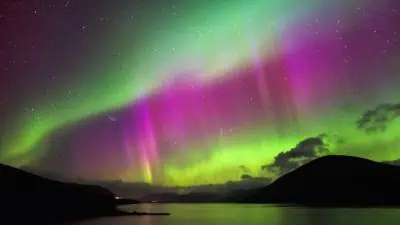Northern Lights

Seeing the Northern Lights is definitely on my bucket list so, living on the south coast, I have been a little envious of the friends I have up north this week who have been sending me their photos of the amazing light display in the skies over where they live.
The Aurora Borealis (uh·raw·ruh baw·ree·aa·luhs) was named by Galileo (of Bohemian Rhapsody fame) after the roman goddess of dawn and the Greek name for the north wind. The astronomical phenomenon is not as the Vikings believed light reflecting of the Valkyrie armour but occurs when energized particles from the sun’s solar winds enter into our upper atmosphere at speeds of up to 45 million miles per hour.
The Earth’s magnetic field directs the particles towards the poles, which is why they are more dramatic and frequent there (there are southern lights too). The colours are determined by the chemical composition of the atmosphere – often this is nitrogen which produces the red colour and oxygen producing the green colour. The solar winds from the sun vary in strength and seemingly go through an 11 year cycle – with the next height in actively predicted to come in 2025 – but the stronger the winds the more extreme amount of energy created and the further south the lights can be seen.
All this talk of the Aurora reminded me of a recent visit I made to the natural history museum, I love the museum and when I was a child it was my preferred choice for my birthday outings. When I was kid, I used to marvel at the dinosaurs, the animals, the sea life, the birds. But on my recent visit I found myself marvelling more at the building itself, which really is a cathedral to nature and at some of the rooms I would have simply passed by when I was young. For example, I would have walk past all the geology stuff but I on this visit found, hidden at the back of room full rocks in display cases, a room called the vault and in there are some really amazing things.
One of the exhibits is named after the Northern Lights and called the Aurora Pyramid of hope, the Aurora Pyramid of hope. It is a collection of nearly 300 naturally coloured ‘fancy’ diamonds. Only 1 in 10,000 diamonds are considered fancy for their colour and this is one of the largest collections – they range from yellow to green to blue to pink. Perfectly formed clear diamonds only consist of one element carbon, yet when impurities are present, they will not be perfectly clear. Often these impurities are where nitrogen is present, and this produces a pale off yellow or brown colour these are the diamonds often used in manufacturing and industry. But occasionally the colours are bright, the colour determined by the element causing the imperfection, sometimes not only are they vivid but they can glow fluorescent under ultraviolent light.
Diamonds form in the extreme temperatures in the Earth’s Mantle 100 miles underground, we don’t exactly know how, other than the intense pressure and the heat.
I loved everything about the Aurora Pyramid of Hope, including its name. To me it clearly signposted the truth that the dawn (remember aurora means dawn) of a new hope lies in us all coming to together, regardless of our colour, of our differences. We all bring something special, we just to need someone to shine the right light on us. I also liked the idea of a pyramid of hope where we build on each other and can only shine our brightest with the support of others and in giving others support. And maybe most importantly none of us are perfect in fact it is our imperfections that make us special. Just like these solar particles entering our atmosphere at crazy speed and the intense heat needed to foam the diamonds – we also need some pressure to really have the opportunity to show our true quality.
“And above all, watch with glittering eyes the whole world around you because the greatest secrets are always hidden in the most unlikely places. Those who don’t believe in magic will never find it.” Roald Dahl



